DOMS™️
The world's most powerful learning design engine
Leverage the power of learning science & AI to transform your learning experience

Dr Philippa Hardman, Cambridge University Scholar, Learning Scientist & Creator of DOMS™️
Join thousands of people who get free, actionable tips on how to design evidence-based learning experiences every week
About DOMS™️
learning design is broken
Millions of us design & deliver learning experiences every year, but research shows that less than 3% of them are optimised for learner motivation, mastery & joy.
Why? Because the science of learning - i.e. research into how humans learn - is locked behind pay walls & hidden in ivory towers.

DOMS™️ is a learning design process that makes it easy to apply the science of learning to the art of learning experience design.
The DOMS™️ Process
A learning design process with a PhD
Evidence-Based learning design made easy:
20+ years of research distilled into a 4-step design process & four easy-to-apply course design frameworks
250+ pieces of always-updating learning science research under the hood
Step 1: Discovery
the science of learner-centricity
DOMS Learner Transformation Framework™️
Step 2: Objectives
the science of desirable difficulty
DOMS ABCD Objectives Framework™️
Step 3: Mapping
the science of motivation & mastery
DOMS Edge of Possible Framework™️
Step 4: Storyboarding
the science of experience & interaction
DOMS Minimal Viable Content Framework™️
Proven Impact 🚀
About Phil
The Prof. of Learning Science
TedX Speaker | EduFlow Top Learning Influencer, 2023

Hey 👋 — I’m Phil, a Cambridge University scholar & creator of DOMS™️.I've spent 20+ years researching learning science & designing in the flesh, online & hybrid learning experiences.I've designed some of the world's most high-impact & profitable online courses in the world for some of the world’s best known brands, institutions & influencers.Learning experiences are broken - let's fix them, together.
I'm on a mission to empower everyone to design like the world's best learning designer - join me!
DOMS™️ Free Guides & Podcasts
I get asked lots of questions every day - everything from what the research tells us about assessment design to how to turn an idea into a seven-figure online course.Here are some free guides, based on the questions I get asked most.
Learning Science 101
Five key lessons from the research for learning designers
AI for Learning Designers
Two ways to optimise learner motivation & mastery using AI
Dr Phil's Work on Gumroad
Download guides & other resources, incl. podcasts
Learning Science 101
Five key lessons from the research for course designers
The one question I get asked more than any other is: what does the research tell us about how we should design learning experiences?Here’s my answer, broken down into five golden design rules:
Design Rule #1: Learners learn best when information is minimised & presented in a way that doesn’t unnecessarily tax their working memory.What it means in practice: use the DOMS™️ Minimal Viable Content Framework to ensure the correct balance of content and activity - i.e. 10% prompt content, 80% activity, 10% feedback.When selecting modes, be mindful of cognitive load - e.g. a 3 min video or piece of audio is far less of a strain on working memory than the same 500 words delivered as text on a page.If you read one thing…. **Hardman, 2022 **
Design Rule #2: Learners learn best when learning objectives & outcomes are aligned to their personal as well as professional and “in course” goals.What it means in practice: take time to understand your learners’ personal & professional pain & aspirations.Use the DOMS™️ Learner Transformation Framework to deep dive your learners' "why". Ensure that you have a crystal clear understanding of who your learner is and how to motivate them through both the content & the structure of your course.If you read one thing…. Mager, 1997
Design Rule #3: Learners learn better when the learning experience progresses from simple to complex at an appropriate level for the learners in question.What it means in practice: take time to understand your learners’ Zone of Proximal Development.Take time to map out two things: 1. what your learners already know and can do, 2. what your learns want to know & be able to do.Next, identify: 1. what your learners could learn without your help (e.g via YouTube or a book), and 2. what your learners could never realistically achieve in a single learning experience, even with your help.Between these two extremes is your learners' so-called Zone of Proximal Development (ZPD).The ZPD contains knowledge and skills that your learners can only achieve with your help, and at a stretch within the confines of a single learning experience. This is your course “sweet spot” and where your experience needs to sit in order to optimise for motivation & mastery and deliver value.If you read one thing…. Vygotsky, 1978
Design Rule #4: Learners learn better when they are driven more by internal reasons than external rewards or consequences.What it means in practice: take time to understand & articulate how the experience is connected with your learners’ broader personal & professional goals (see Rule #1).To really drive your learners' motivation you need to make sure that they feel a sense of of competence & progression towards both their course & life goals (e.g. through feedback) regularly, ideally at least once per hour.If you read one thing…. Ryan & Deci, 2000
Design Rule #5: Learners learn best when the experience is as authentic as possible.What it means in practice: as a rule, the most effective design strategy is to select content, activities, assessments & modes which best replicate real scenarios.We often think of immersive learning as complex experiences involving virtual realities or work placements, but simple strategies like using case studies & having learners work on real problems using real assets (e.g. give feedback on a real life project plan) is as effective at building an authentic experience and supporting learning transfer as more complex approaches.If you read one thing…. Herrington & Herrington, 2007
____If you want to keep on top of all the latest learning science research, distilled into course design practices, sign up to my monthly Learning Science Digest.Happy Designing!
Phil 👋
AI for Learning Designers
Two ways to optimise learner motivation & mastery using AI
Whether we like it or not, AI will change how we design and deliver learning experiences.The good news is that, used with intention, AI can be a powerful tool for delivering learning strategies that we know drive motivation and mastery of the subject.Here are two ways you can use free, open source AI to optimise your learning experience for learner motivation & mastery.
#1: Use AI to Optimise Your FeedbackFeedback is most powerful when it is:
Delivered rapidly after a learner completes a task
Individualised to the learner's performance
Motivational
Focused as much on what to do next, as what has been done
Part of an open feedback loop - i.e. students can respond with questions and/or get further feedback on an iterated version of their response
Initial experimentation with ChatGPT suggests that AI is capable of all of the above.On copying and pasting a series of essays into ChatGPT, the feedback I received was consistently:
Immediate
Individualised to my performance
Motivational and positive
Focused as much on what to do next, as what has been done
Part of an open feedback loop, enabling me to respond with questions and/or get further feedback on an iterated version of my essay
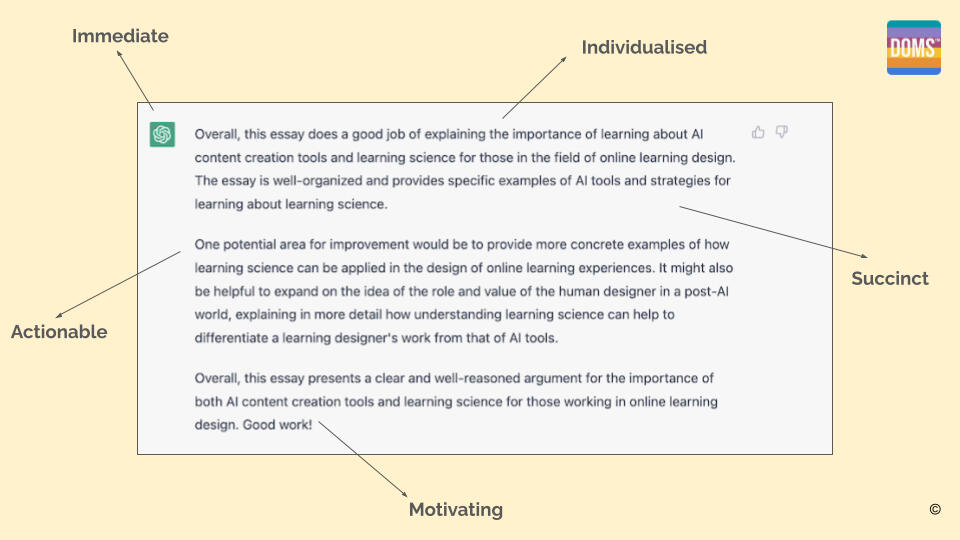
Initial research suggests that AI is capable of delivering high quality, immediate feedback in a way that even the most committed educator simply cannot compete with.These findings open us some incredibly exciting potential to solve the until-now wicked problem of scaling high quality feedback, which has for so long limited our ability to deliver high quality learning experiences to anyone, anywhere.Try it now for yourself!
#2: Use AI to Optimise Your Learning ObjectivesResearch shows that objectives are optimised when they are:
Learner-Centered - addressed directly to the learner, and mapped to their personal and professional goals
Focused on the Why [as well as the what] - they include "so that you can" statements which help with motivation
Measurable - it is possible to measure how well the objective is met, and how this is achieved is made clear to the learner
My early experimentation with ChatGPT suggests that AI is capable of making it easy to write objectives that are optimised for learner motivation and mastery:
Step 1: I asked ChatGPT to write me some objectives for a course on sustainability leadership for leaders with no experience of sustainability - the results were, well, not too bad. Probably similar to that of a junior learning designer or teacher:
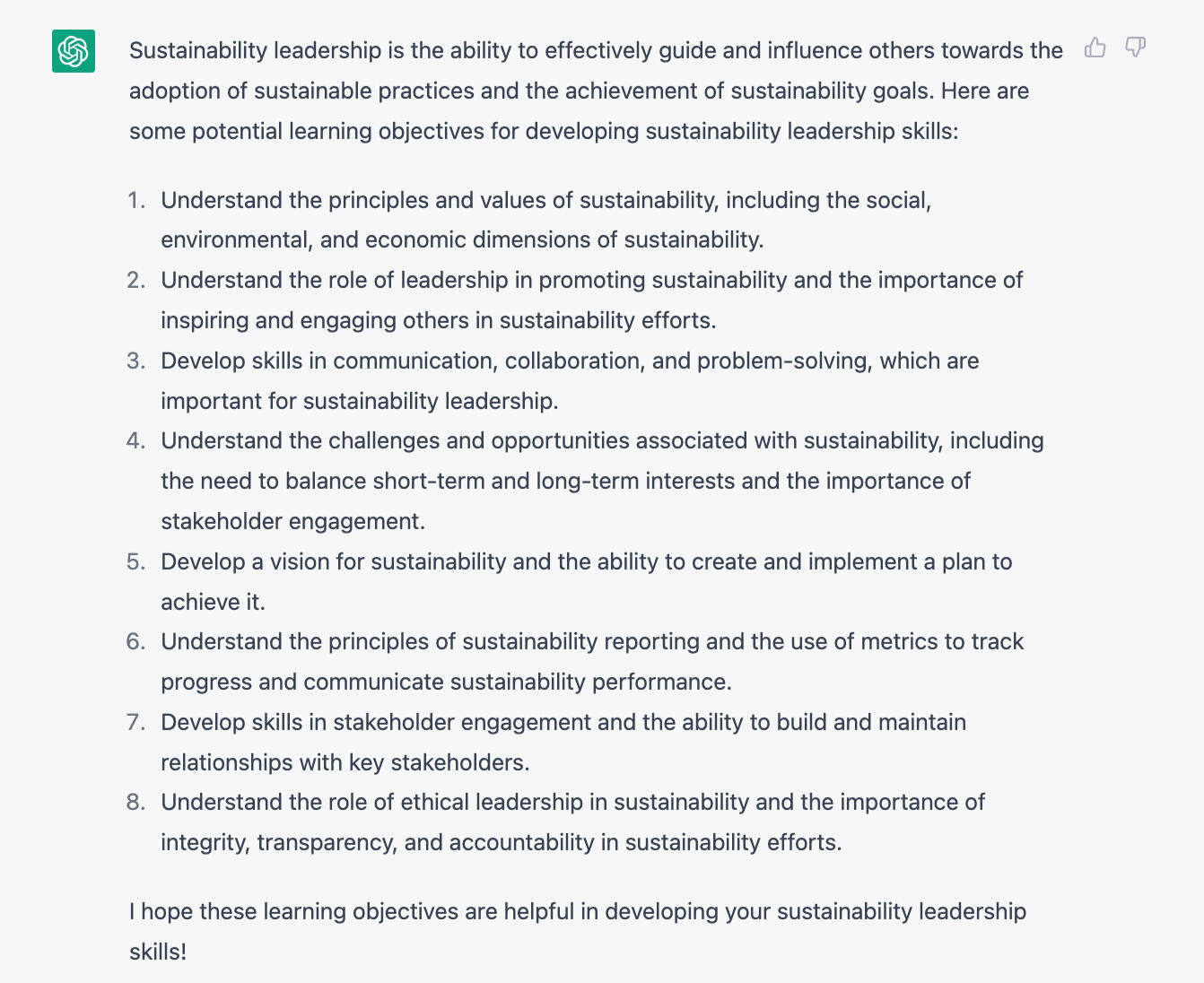
Step 2: To optimise the objectives for motivation, I asked ChatGPT to add "so that you can" statements to the end of each of my objectives.The AI did exactly as I asked. Immediately the rationale + use of "you" language made the objectives more focused and motivating:
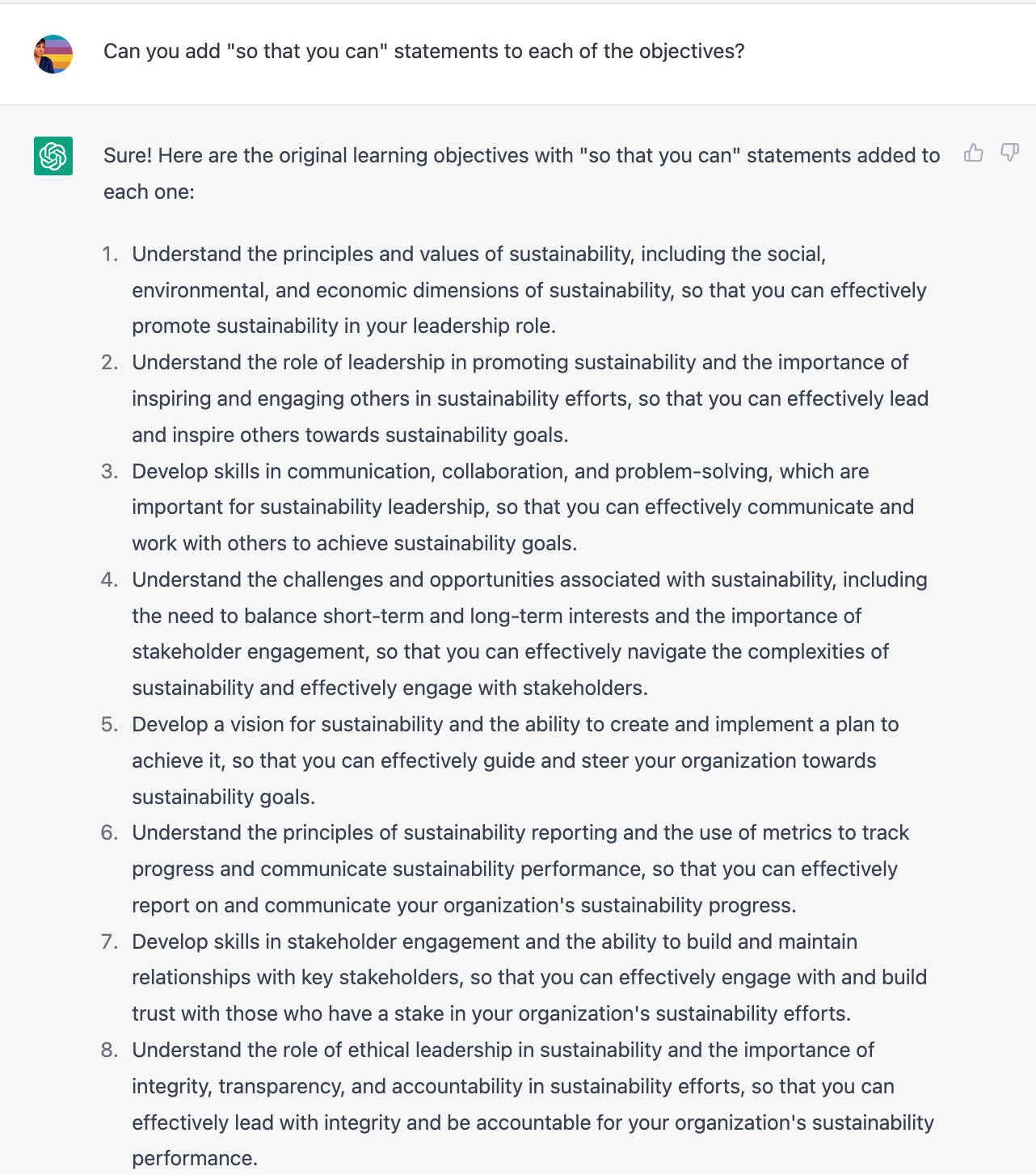
Step 3: Next, I asked ChatGPT to make them more measurable. Here's what it came up with:
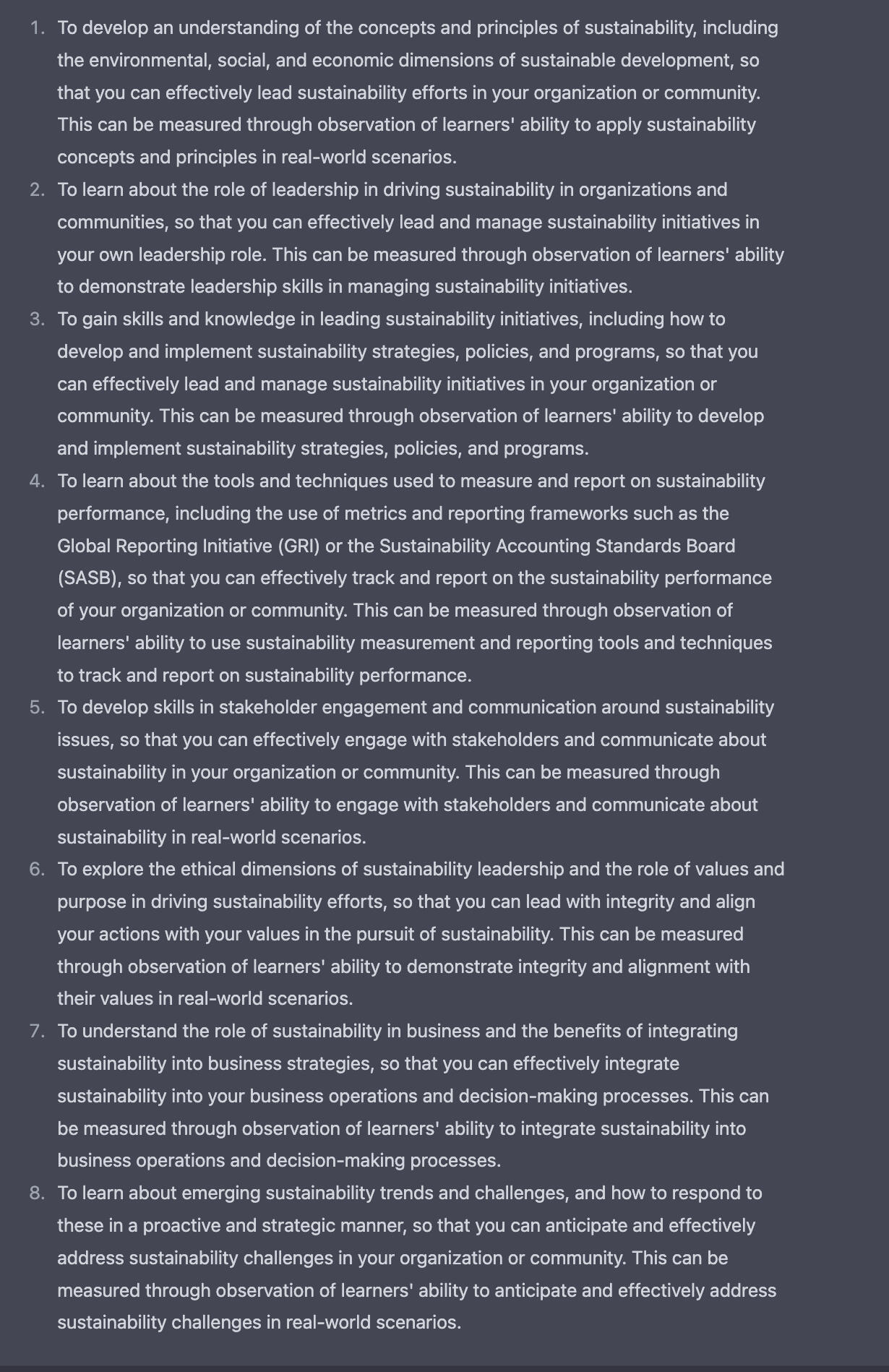
Step 4: The objectives were taking shape, but they were also getting a bit confusing (written in third person + first person).So, I asked ChatGPT to turn them into learner-facing "you will" statements:
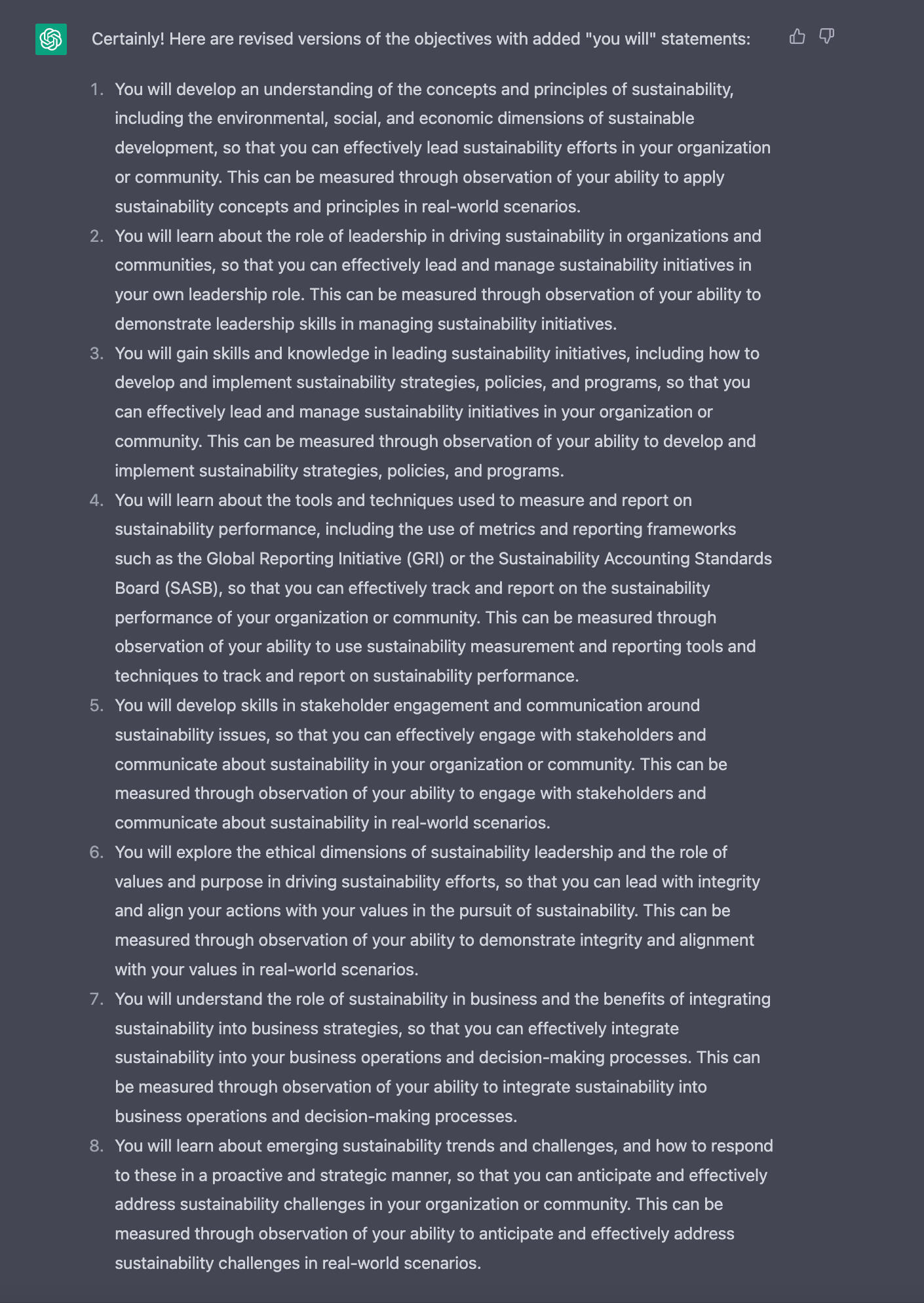
Step 5: I wanted to ensure adequate stretch, so I asked AI to only use Bloom’s higher order verbs. It got straight on to it:
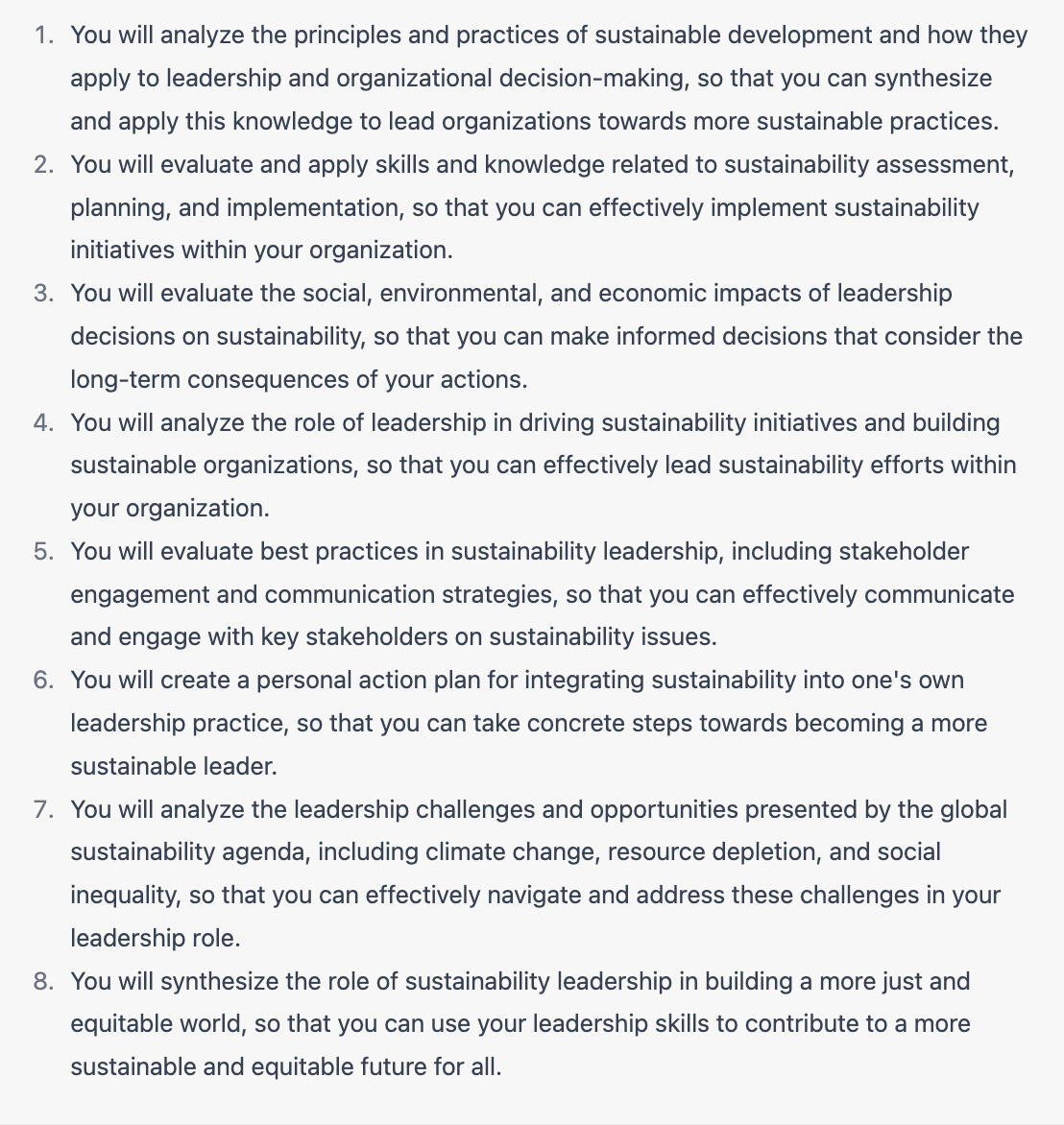
Step 6: So I can communicate to my learners how their performance will be measured, I asked ChatGPT to rustle me up an assessment rubric.It created four levels of mastery for each objective. Here's an example of what it wrote for objective #1:
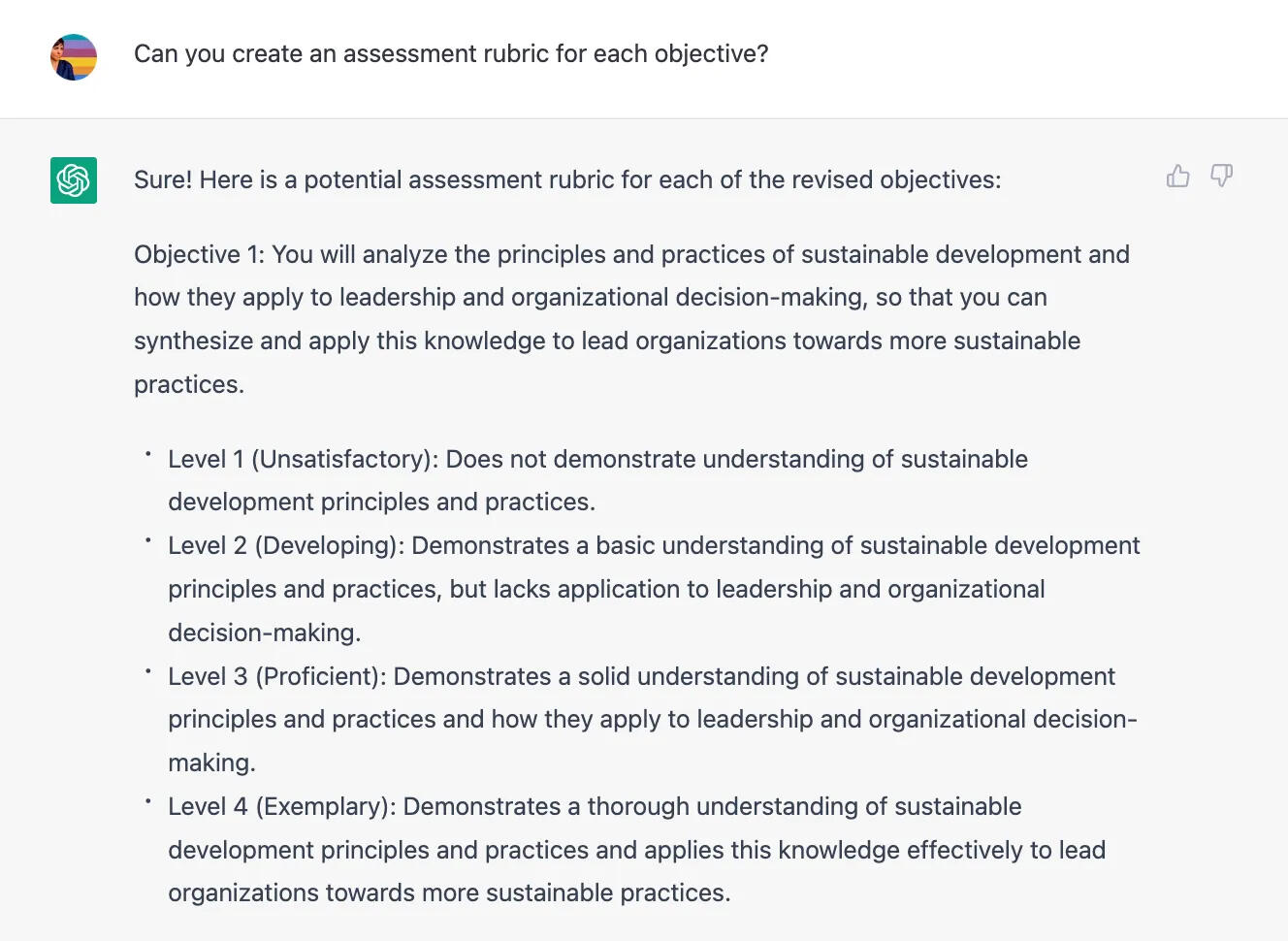
Bingo! Through asking the right questions, I was able to create an above-average set of learning objectives in ~2 minutes - a great starting point.For laughs, I asked the AI to create me two more versions of the objectives, one more and one less challenging. It did both with ease.Overall, I think this a great example of the power of combined human + AI expertise, and a fascinating window into the world of Learning Design 3.0.For now at least, AI plays a game-changing role in accelerating the learning design process, but the Learning Designer plays an essential part in acting as coach & expert to turn AI-generated objectives into objectives capable of driving learner motivation & mastery.Try it now for yourself!
If you want to learn more about AI and other emerging technologies, sign up to my Learning Futures Digest.Happy Designing!Phil 👋
Course Ideation 101
A five step process to generate a high-leverage course idea
A question I get asked a lot is, how do I know if my course idea is a good one? If I build it, will they come?.The harsh truth is that of the millions of courses that we put online every year, only ~3% find Course Market Fit.In practice, this means only 3% of courses inspire learners to complete & tell others about it in numbers large enough to drive growth, impact & profitability.So, how do you avoid common errors and optimise your course idea for Course Market Fit?
The Formula for Course Market Fit (CMF)My research shows that course creators build the wrong thing because they misunderstand the formula for CMF.Most course creators think they will deliver a successful course if they:
have deep expertise in their subject
produce high quality video content
invest heavily in marketing & SEO
In reality, CMF lies at the intersection of what you know (aka your unique insight) and what the world needs (aka learner pain).Research shows that those courses which achieve Course Market Fit:
act like painkillers, not vitamins
solve a burning, "hair on fire" problem
offer something unique, based on the creator's unique journey & experience
The DOMS™️ Course Ideation Framework takes what we know about how & why humans learn and translates it into a four step process to help optimise your course idea for learner attraction, value & revenue.Use it today to eliminate tumbleweed & put you on the track to achieve learner joy & Course Market Fit.
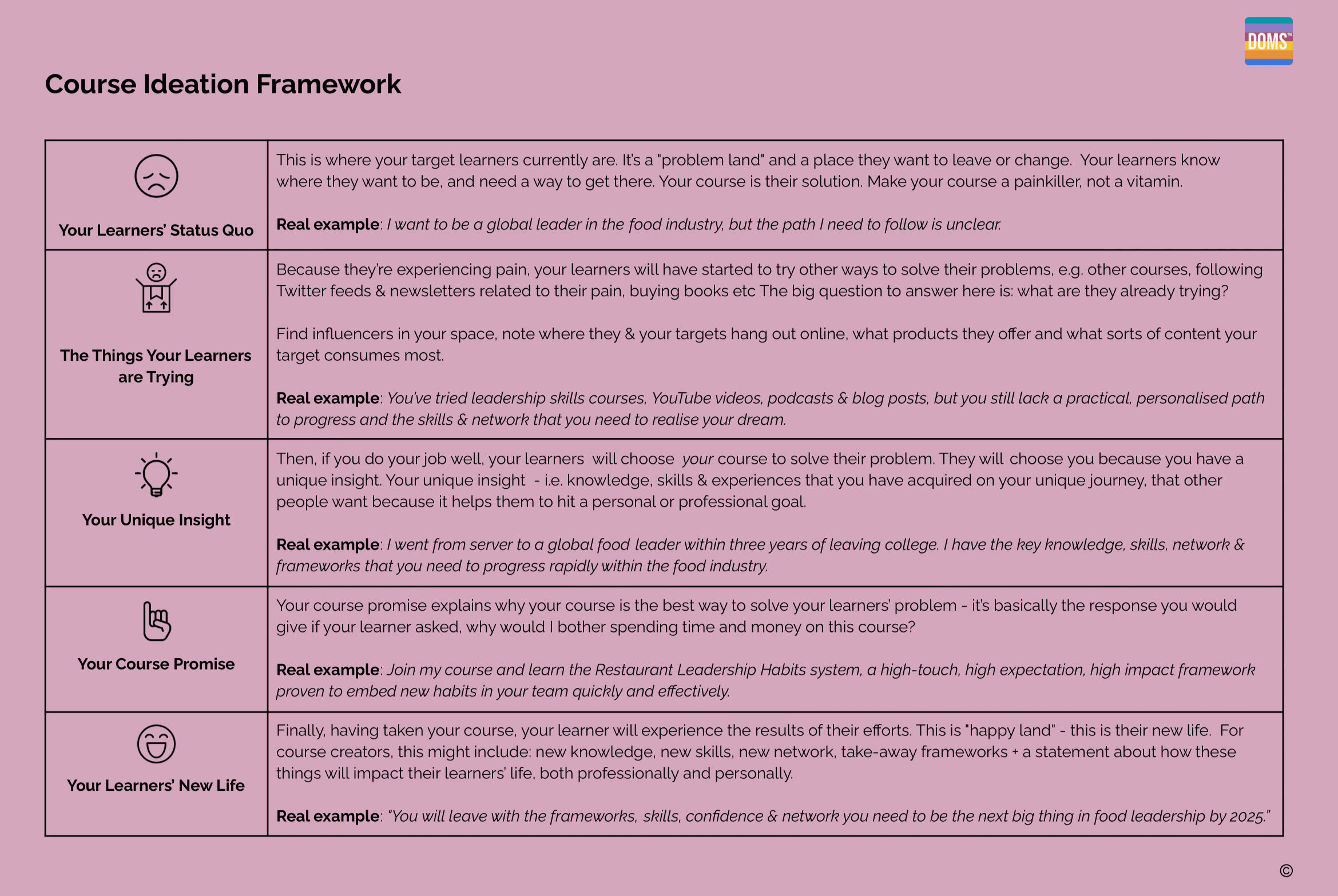
If you want to learn more about the science of course design, sign up to my weekly Course Design Newsletter.Happy Designing!Phil 👋
DOMS™️ Courses
The AI-Powered Learning Science Bootcamp
Get to know the science of learning and hone your AI knowledge to get ahead of the curve, with phil
3 week cohort-based course, £995
The Post-AI Educator: an async guided project
Get to the know the basics of AI & learning science & start to hone your skills for a post-AI world, with phil
Async guided project, £149
DOMS™️ Learning Science Courses
Learning Science Bootcamp: Premium
A cohort-based, certified course to hone your evidence-based learning design skills, coached by Phil & powered by DOMS™️
£995
Learning Science Bootcamp:
Light
A hands-on, self-paced course to hone your evidence-based learning design skills, led by Phil & powered by DOMS™️
£299
Coming soon
DOMS™️ AI-Ed Courses
The Post-AI Educator
A practical, hands-on, self-paced course to introduce the what, why & how of AI in education, led by Phil
£149
AI for Educators: Premium
A cohort-based, certified course to become expert in the what why & how of AI in education, led by Phil
£995
Coming soon
The AI-Powered Learning Science Bootcamp
A 3 week, hands-on cohort based course to hone your evidence-based learning design skills with phil, powered by DOMS™️ & AI
3 weeks, 3 hands-on projects
weekly workshops, led by phil
dedicated course community, led by Phil
learn how to use the doms™️ Process, principles & frameworks to optimise your learning experiences for learner motivation, mastery and impact
Learn how to use cutting edge ai tools + prompts to optimise your learning design & development process
get feedback on your course design from phil
get coaching on your evidence-based design skills from phil
leave with a course design, a best-in-class design process for life & a powerful network of educators like you
"Genuinely the best course I have ever experienced - it changed everything & will resonate forever."
Cohorts run monthly - apply now!
£995
DOMS™️ Course Creator Bootcamp
A 4 week, hands-on cohort based course to design, validate & build a seven-figure online course, powered by DOMS™️ + AI
4 weeks, 7 projects
Access to a course community, led by phil
Access to a process & set of course design frameworks + prompts proven to 10X course attraction & revenue
get feedback on your course design from phil
leave with a validated, ready-to-launch optimised for Course Market Fit + tailored marketing strategy & comms
Beta in progress: apply now!
£3,999 £2,999
Learning Science Bootcamp: Light
A hands-on, self-paced course which explores evidence-based learning design & its impact on learner motivation & mastery
4 hands-on, video-based projects
learn how to use the doms™️ Process, principles & frameworks to optimise your learning designs for learner motivation & mastery
leave with a best-in-class, evidence-based learning design process for life
Coming Soon (Spring, 2023)
£399
The Post-AI Educator
A hands-on, online guided project to help educators (K12, HE, workplace L&D) get AI-ready & stay ahead of the curve
In this async online guided project, we’ll work together 1:1 to explore the impact of AI on your role. We’ll tackle five short, hands-on projects to help you to develop the key knowledge & skills you need to stay ahead of the curve and excel in the post-AI classroom.
✍🏽 Project 1: Post-AI Lesson Design
✍🏽 Project 2: Post-AI Assessment Design
✍🏽 Project 3: Post-AI Facilitation
✍🏽 Project 4: Data Analysis
✍🏽 Project 5: AI Knowledge Building
Coming Soon (June, 2023)
£149
DOMS™️ @ Work
team-based training, led by phil
DOMS™️ @ Work Bootcamps
bespoke cohort-based courses to hone your team's learning design process, principles & skills, led by phil
DOMS™️ @ Work Sprints
bespoke video-based courses to hone your team's learning design process, principles & skills, led by phil
DOMS™️ Subscriptions
Join thousands of people who get actionable tips on how to design winning, evidence-based online courses powered by DOMS™️
DOMS™️ Learning Science Newsletter
Free weekly tips on how to design evidence-based learning experiences powered by science
DOMS™️ Learning Research Digest
A monthly digest of learning science research distilled into learning design practices
DOMS™️ Learning Futures Digest
A monthly digest of cutting edge technologies & their impact on how we teach & learn